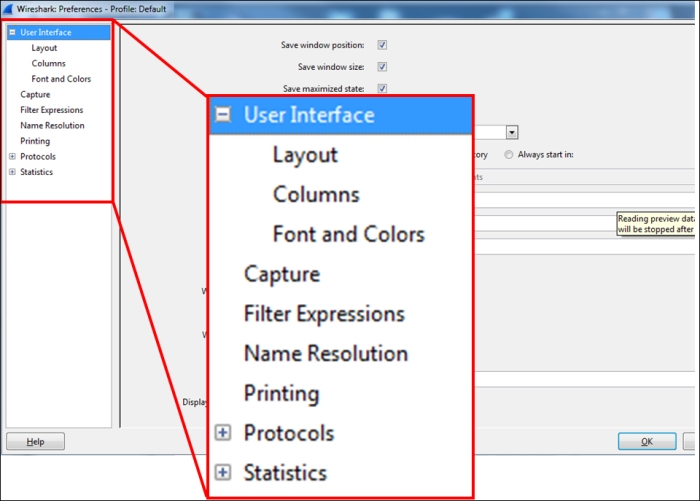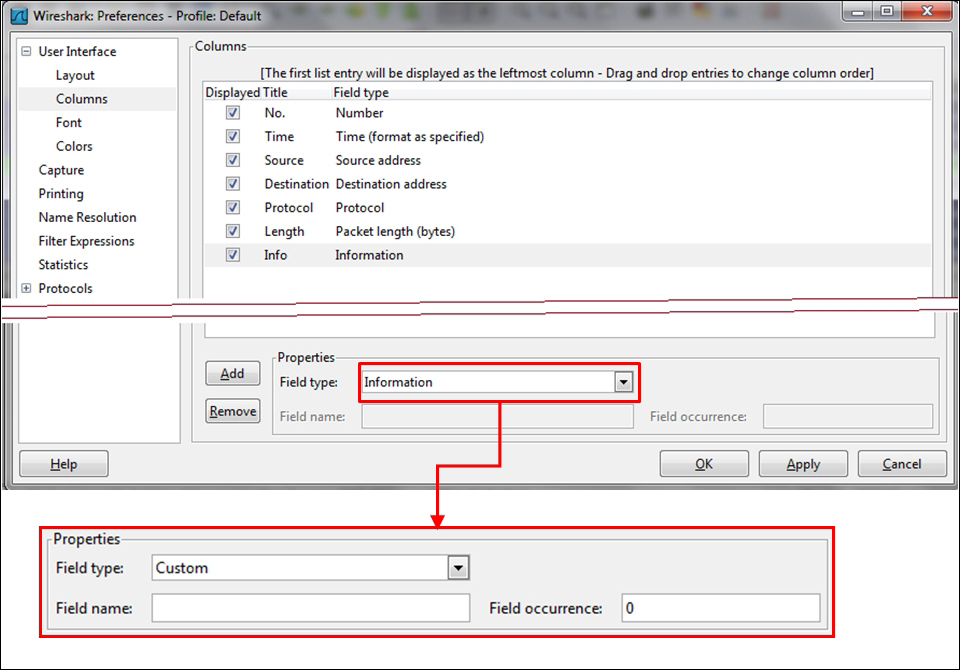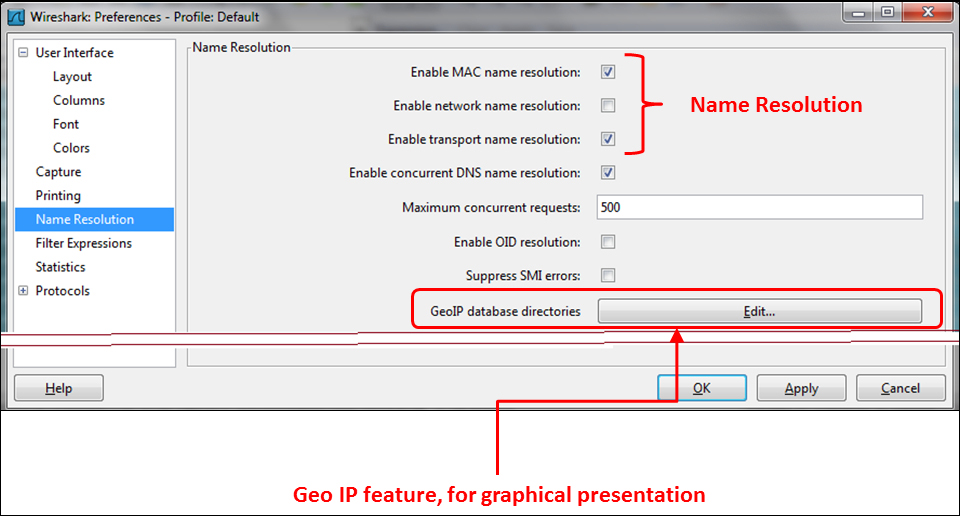 Configuring the user interface in the Preferences menu
by Charit Mishra, Yoram Orzach, James H Baxter
Wireshark Revealed: Essential Skills for IT Professionals
Configuring the user interface in the Preferences menu
by Charit Mishra, Yoram Orzach, James H Baxter
Wireshark Revealed: Essential Skills for IT Professionals
- Wireshark Revealed: Essential Skills for IT Professionals
- Table of Contents
- Wireshark Revealed: Essential Skills for IT Professionals
- Credits
- Preface
- 1. Module 1
- 1. Getting Acquainted with Wireshark
- 2. Networking for Packet Analysts
- The OSI model – why it matters
- IP networks and subnets
- Switching and routing packets
- WAN links
- Wireless networking
- Summary
- 3. Capturing All the Right Packets
- Picking the best capture point
- Test Access Ports and switch port mirroring
- Capturing interfaces, filters, and options
- Verifying a good capture
- Saving the bulk capture file
- Isolating conversations of interest
- Using the Conversations window
- Wireshark display filters
- Filter Expression Buttons
- Following TCP/UDP/SSL streams
- Marking and ignoring packets
- Saving the filtered traffic
- Summary
- 4. Configuring Wireshark
- 5. Network Protocols
- The OSI and DARPA reference models
- Transport layer protocols
- Application layer protocols
- Summary
- 6. Troubleshooting and Performance Analysis
- Troubleshooting methodology
- Troubleshooting connectivity issues
- Troubleshooting functional issues
- Performance analysis methodology
- Top five reasons for poor application performance
- Summary
- 7. Packet Analysis for Security Tasks
- 8. Command-line and Other Utilities
- 2. Module 2
- 1. Introducing Wireshark
- 2. Using Capture Filters
- 3. Using Display Filters
- 4. Using Basic Statistics Tools
- Introduction
- Using the Summary tool from the Statistics menu
- Using the Protocol Hierarchy tool from the Statistics menu
- Using the Conversations tool from the Statistics menu
- Using the Endpoints tool from the Statistics menu
- Using the HTTP tool from the Statistics menu
- Configuring Flow Graph for viewing TCP flows
- Creating IP-based statistics
- 5. Using Advanced Statistics Tools
- Introduction
- Configuring IO Graphs with filters for measuring network performance issues
- Throughput measurements with IO Graph
- Advanced IO Graph configurations with advanced Y-Axis parameters
- Getting information through TCP stream graphs – the Time-Sequence (Stevens) window
- Getting information through TCP stream graphs – the Time-Sequence (tcp-trace) window
- Getting information through TCP stream graphs – the Throughput Graph window
- Getting information through TCP stream graphs – the Round Trip Time window
- Getting information through TCP stream graphs – the Window Scaling Graph window
- 6. Using the Expert Infos Window
- 7. Ethernet, LAN Switching, and Wireless LAN
- 8. ARP and IP Analysis
- 9. UDP/TCP Analysis
- Introduction
- Configuring TCP and UDP preferences for troubleshooting
- TCP connection problems
- TCP retransmission – where do they come from and why
- Duplicate ACKs and fast retransmissions
- TCP out-of-order packet events
- TCP Zero Window, Window Full, Window Change, and other Window indicators
- TCP resets and why they happen
- 10. HTTP and DNS
- 11. Analyzing Enterprise Applications' Behavior
- Introduction
- Finding out what is running over your network
- Analyzing FTP problems
- Analyzing e-mail traffic and troubleshooting e-mail problems – POP, IMAP, and SMTP
- Analyzing MS-TS and Citrix communications problems
- Analyzing problems in the NetBIOS protocols
- Analyzing database traffic and common problems
- 12. SIP, Multimedia, and IP Telephony
- Introduction
- Using Wireshark's features for telephony and multimedia analysis
- Analyzing SIP connectivity
- Analyzing RTP/RTCP connectivity
- Troubleshooting scenarios for video and surveillance applications
- Troubleshooting scenarios for IPTV applications
- Troubleshooting scenarios for video conferencing applications
- Troubleshooting RTSP
- 13. Troubleshooting Bandwidth and Delay Problems
- 14. Understanding Network Security
- A. Links, Tools, and Reading
- 3. Module 3
- 1. Welcome to the World of Packet Analysis with Wireshark
- 2. Filtering Our Way in Wireshark
- 3. Mastering the Advanced Features of Wireshark
- 4. Inspecting Application Layer Protocols
- 5. Analyzing Transport Layer Protocols
- 6. Analyzing Traffic in Thin Air
- 7. Network Security Analysis
- 8. Troubleshooting
- 9. Introduction to Wireshark v2
- Bibliography
- Index
There are a large number of parameters you can change in the Preferences window, including what data is presented, where files are saved by default, what is the default interface that Wireshark captures data from, and many more.
What we will refer to in this chapter are the common parameters that when changed will help us with various capture scenarios.
For configuring User Interface, we will choose the Preferences option from the Edit menu. You will get the following window:

We will look at the configuration of the following parameters:
- Columns
- Capture
- Name Resolution
In this section we will see how to change parameters that will help in working with Wireshark.
The default columns that we see in the packet pane are the number, time, source and destination addresses, protocol, length, and information columns, as shown in the following screenshot:

To add a new column to the packet pane:
- You can choose one of the predefined parameters to be added as a new column from the Field type. Among these parameters are time delta, IP DSCP value, port numbers, and others.
- A very important feature comes up when you fill in Custom in the field type. In this case, you can fill in any filter string for Field name. You can, for example, add the following:
- Add the string
tcp.window_sizeto view the TCP window size (that influences performance). - Add the string
ip.ttlto view the IP TTL (Time-To-Live) parameter of every packet. - Add
rtp.markerto view every instance of a marker set in an RTP packet. - As we will see in the later chapters, this feature will assist us a lot for fast resolutions of network problems.
- Add the string
There are some parameters that can be configured before capturing data. In the Preferences window choose the Capture menu, and the following window will come up:

For changing the default interface that the capture will start from, just click on the Edit button, and mark the interface you would like to be the default. Of course you can change it every time you start a new capture, this is only the default.
Wireshark supports Name Resolution in three layers:
- Layer 2: by resolving the first part of the MAC addresses to the vendor name. For example, 14:da:e9 will be presented as AsusTeckC (ASUSTeK Computer Inc.).
- Layer 3: by resolving IP addresses to the DNS names. For example, 157.166.226.46 will be resolved to www.edition.cnn.com.
- Layer 4: by resolving TCP/UDP port numbers to port names. For example, port 80 will be resolved as HTTP, and port 53 as DNS.

The Wireshark default is to resolve layer-2 MAC addresses and layer-4 TCP/UDP port numbers. Resolving IP addresses can slow down Wireshark due to a large amount of DNS queries that it uses; therefore, use it carefully.
Very simple. This is the configuration menu for the Wireshark. Here you can configure parameters as described in this recipe, along with some other parameters. You can refer to Wireshark manuals at www.wireshark.org for further information.
-
No Comment